
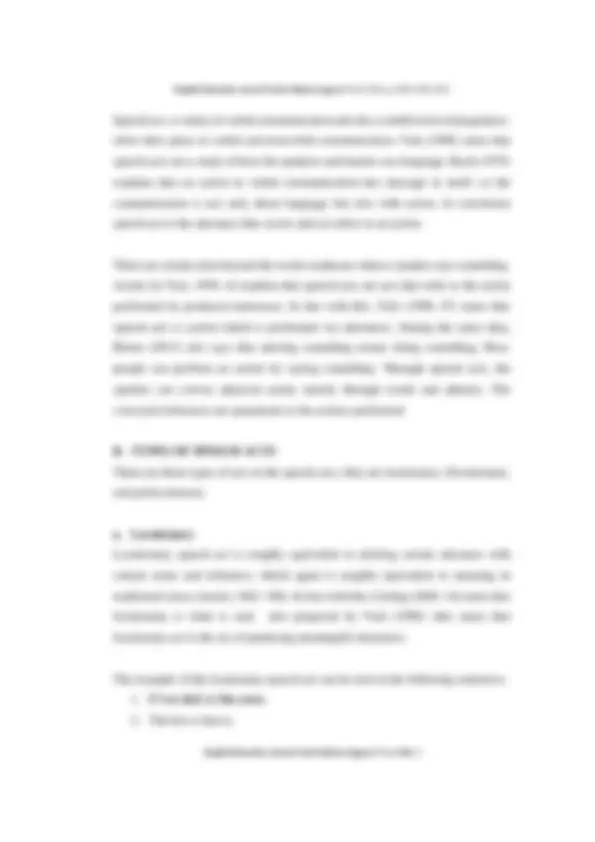
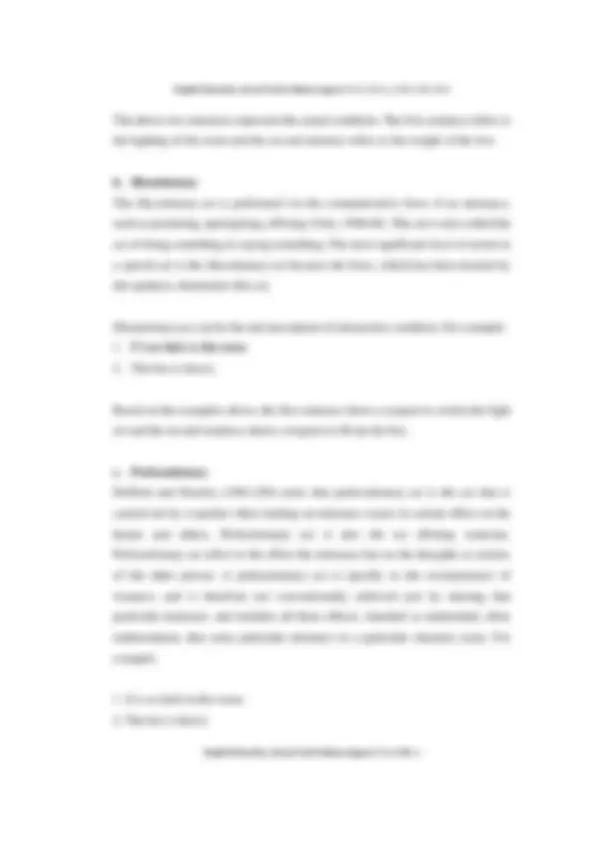
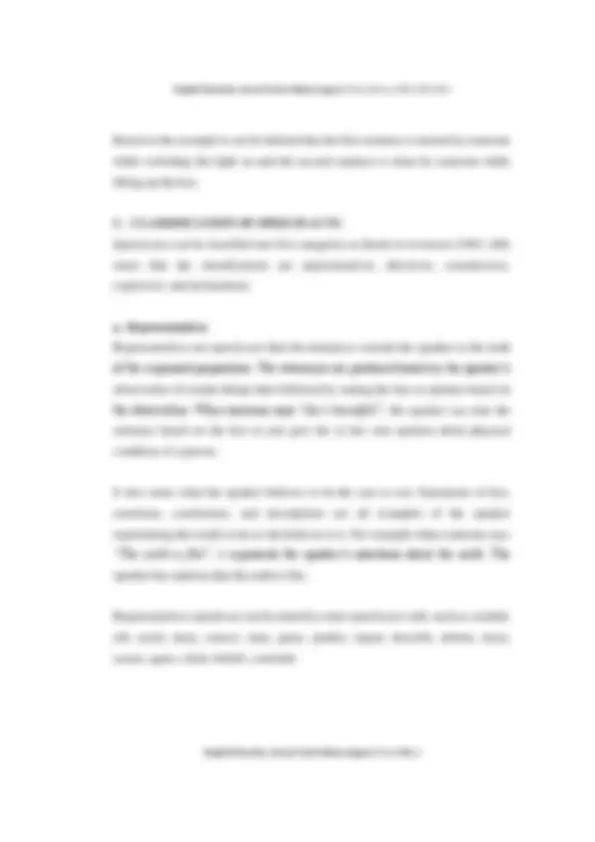

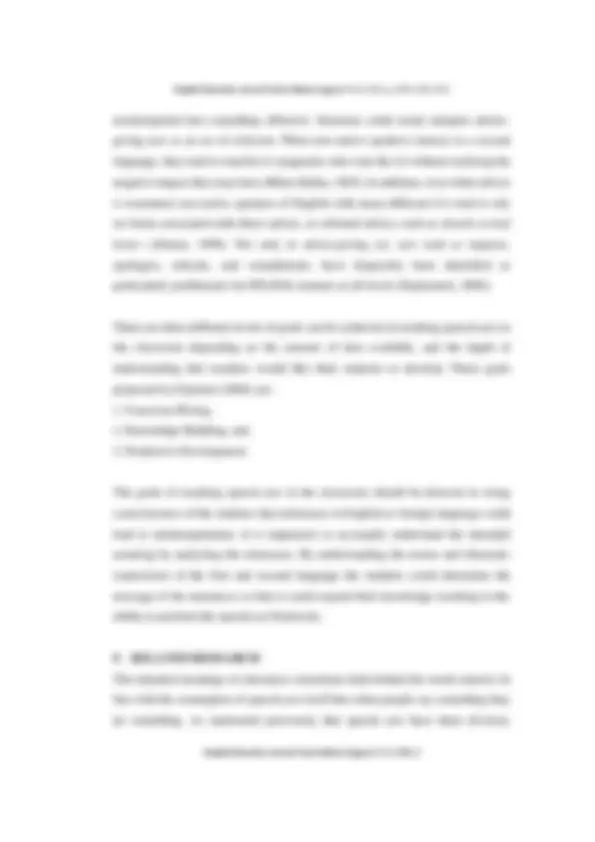
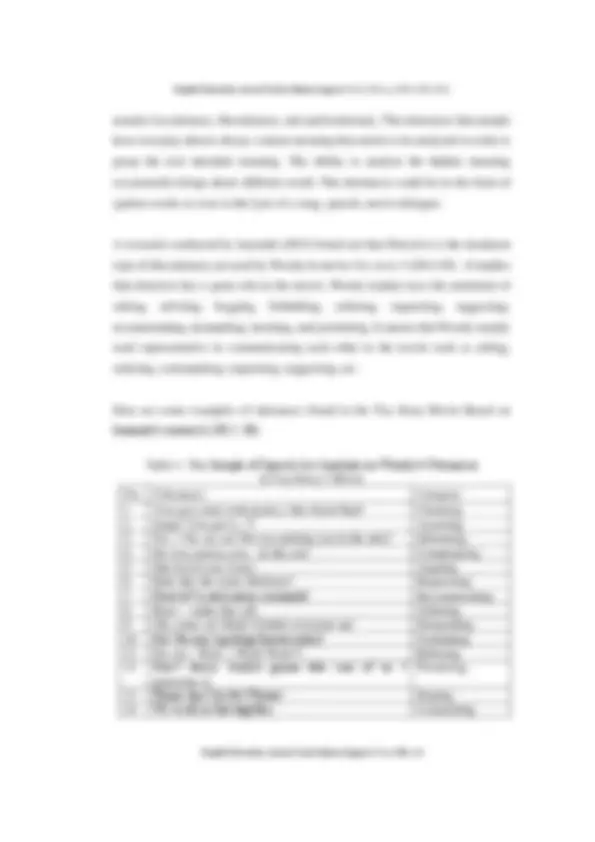


Study with the several resources on Docsity

Earn points by helping other students or get them with a premium plan


Prepare for your exams
Study with the several resources on Docsity

Earn points to download
Earn points by helping other students or get them with a premium plan
Community
Ask the community for help and clear up your study doubts
Discover the best universities in your country according to Docsity users
Free resources
Download our free guides on studying techniques, anxiety management strategies, and thesis advice from Docsity tutors
Speech acts are acts that refer to the action performed by produced utterances. People can perform an action by saying something.
Typology: Summaries
1 / 12

This page cannot be seen from the preview
Don't miss anything!







Available online at: http:ejournal.radenintan.ac.id/index.php/ENGEDU English Education: Jurnal Tadris Bahasa Inggris p-ISSN 2086- Vol 9 (1), 2016, 1-
Agus Hidayat IAIN Raden Intan Lampung Email: hidayatagus_88@yahoo.com Abstract. Speech act is a part of pragmatics where there are certain aims beyond the words or phrases when a speaker says something. Speech acts are acts that refer to the action performed by produced utterances. People can perform an action by saying something. Through speech acts, the speaker can convey physical action merely through words and phrases. The conveyed utterances are paramount to the actions performed. In regard to the English as a foreign language, there are things to consider. It is easy for the speakers or listeners to determine the intended meaning of utterances if they are spoken in the mother tongue. Factors such as idiomatic expressions and cultural norms are not function as barriers to determine the intended meaning.
Keywords: pragmatics, speech acts, norms and idiomatic expressi ons
A. DEFINITION OF SPEECH ACTS Communication has always been a necessity in human life. Through communication, the trade of thought among people, which directly contributes to the development of the quality of life itself, can be performed. The ability to percept utterances in communication can determine the actions followed. Communication can be conveyed through verbal and nonverbal communication. Buck (2002) states that there are two types of communication, they are verbal and nonverbal communication. Verbal communication is the way of communicating messages by using words as elements. Nonverbal communication is the way of communicating messages by using gesture, body movements, eye contact, facial expression, or general appearances as the elements.
Pragmatics is a study which belief is what is communicated is more than what is said. The utterances that the speakers produce in communication contain deeper sense than the actual meaning of the words or phrases themselves. Yule (1996:3) states that pragmatics has consequently more to do with the analysis of what people mean by their utterances than what the words or phrases in those utterances might mean by themselves. Pragmatics also strongly related with context or situation when something is being said, thus it is very important for the speakers to focus on the context. Leech (983: 6) also states that pragmatics is the study of meaning which is related to the speech situations. In accordance to Leech statement, Yule (1996) argues that pragmatics should also consider aspects of context such as who people are talking to, when, where, and under what circumstances that will determine the way they say and what they want to say.
Yule (1996:3) states that there are four areas which pragmatics is concerned with:
In the broad sense, through pragmatics we must be able to grasp the message of the utterances by being aware that the words or phrases contain deeper meaning than literal meaning of what is spoken. In line with this, Richard and Schmidt (2002) argue that pragmatics is the study of the use of language in communication related to sentences and the context and situations in which they are used.
In the scope of pragmatics, there are some factors that should be considered. These factors establish the very definition of pragmatics itself. The factors are Implicature, Speech Acts, Presupposition, Context, Adjacency Pairs, and Deixis and Distance.
The above two sentences represent the actual condition. The first sentence refers to the lighting of the room and the second sentence refers to the weight of the box.
b. Illocutionary The illocutionary act is performed via the communicative force of an utterance, such as promising, apologizing, offering (Yule, 1996:48). This act is also called the act of doing something in saying something. The most significant level of action in a speech act is the illocutionary act because the force, which has been desired by the speakers, determines this act.
Illocutionary act can be the real description of interaction condition. For example:
Based on the examples above, the first sentence shows a request to switch the light on and the second sentence shows a request to lift up the box.
c. Perlocutionary Hufford and Heasley (1983:250) states that perlocutionary act is the act that is carried out by a speaker when making an utterance causes in certain effect on the hearer and others. Perlocutionary act is also the act offering someone. Perlocutionary act refers to the effect the utterance has on the thoughts or actions of the other person. A perlocutionary act is specific to the circumstances of issuance, and is therefore not conventionally achieved just by uttering that particular utterance, and includes all those effects, intended or unintended, often indeterminate, that some particular utterance in a particular situation cause. For example:
Based on the example it can be inferred that the first sentence is uttered by someone while switching the light on and the second sentence is done by someone while lifting up the box.
C. CLASSIFICATION OF SPEECH ACTS Speech acts can be classified into five categories as Searle in Levinson (1983: 240) states that the classifications are representatives, directives, commissives, expressive, and declarations.
a. Representatives Representatives are speech acts that the utterances commit the speaker to the truth of the expressed proposition. The utterances are produced based on the speaker’s observation of certain things then followed by stating the fact or opinion based on the observation. When someone says “ she’s beautiful”, the speaker can state the sentence based on the fact or just give his or her own opinion about physical condition of a person.
It also states what the speaker believes to be the case or not. Statements of fact, assertions, conclusions, and descriptions are all examples of the speaker representing the world as he or she believes it is. For example when someone says “The earth is flat”, it represents the speaker’s assertions about the earth. The speaker has opinion that the earth is flat.
Representatives speech act can be noted by some speech acts verb, such as: remind, tell, assert, deny, correct, state, guess, predict, report, describe, inform, insist, assure, agree, claim, beliefs, conclude.
intended meaning. When it comes to foreign language, those factors could hindrance someone’s ability to truly understand the meaning of utterances. It is hard to perform speech acts in a second language because learners may not know the idiomatic expressions or cultural norms in the second language or they may transfer their first language rules and conventions into the second language, assuming that such rules are universal.
Because the natural tendency for language learners is to fall back on what they know to be appropriate in their first language, it is important that these learners understand exactly what they do in that first language in order to be able to recognize what is transferable to other languages. Something that works in English might not transfer in meaning when translated into the second language. For example, the following remark as uttered by a native English speaker could easily be misinterpreted by a native Chinese hearer:
Sarah : "I couldn’t agree with you more.” Cheng: "Hmmm…." (Thinking: "She couldn’t agree with me? I thought she liked my idea!") (CARLA).
In order to grasp the messages of utterances, one needs to factor in the context when the words are uttered. Hymes (1974) proposed the SPEAKING model of speech analysis. According to Hymes, in order to speak a language correctly, one does not only need to learn its vocabulary and grammar, but also the context in which words are used. In the speaking model aspects of the linguistic situation are considered and applied to various components of a discourse sample or a communicated message.
SPEAKING model of speech analysis (Hymes, 1974):
Based on the theory of SPEAKING, it is possible to determine the intended meaning of utterances by analyzing the factors mentioned. The perception of meaning of utterances can be different based on the context. The time, place, purpose, participant, tone, the media, rules, and type of speech determine the intended meaning of utterances.
E. SPEECH ACTS in ELT In teaching the Speech Act in the classroom the teacher or instructor should consider several things, since English for Indonesian students is the foreign language. The barrier mentioned previously can be found in the classroom setting. When teaching the language expression such as giving advice could be
namely Locutionary, illocutionary, and perlocutionary. The utterances that people hear everyday almost always contain meaning that needs to be analyzed in order to grasp the real intended meaning. The ability to analyze the hidden meaning occasionally brings about different result. The utterances could be in the form of spoken words or even in the lyric of a song, speech, movie dialogue.
A research conducted by Isnaniah (2015) found out that Directive is the dominant type of illocutionary act used by Woody in movie Toy story 3 (2013:38). It implies that directive has a great role in the movie. Woody mainly uses the statement of asking, advising, begging, forbidding, ordering, requesting, suggesting, recommending, demanding, insisting, and permitting. It means that Woody mainly used representative in communicating each other in the movie such as asking, ordering, commanding, requesting, suggesting, etc.
Here are some examples of utterances found in the Toy Story Movie Based on Isnaniah’s research (2012: 38).
Table 1. The Sample of Speech Act Analysis on Woody’s Utterances in Toy Story 3 Movie No. Utterances Category 1 You got a date with justice, One-Eyed Bart! Claiming 2 Sarge! You got it...?! Asserting 3 No...! No, no, no! He was putting you in the attic! Informing 4 He was putting you... In the attic Complaining 5 She loved you, Lotso Arguing 6 Ride like the wind, Bullseye! Requesting 7 Now let‟s catch some criminals! Recommending 8 Buzz -- make the call. Ordering 9 Oh, come on! Slink? Gather everyone up! Demanding 10 No! No one’s getting thrown away! Forbidding 11 No, no... Wait...! Wait! Wait!!! Refusing 12 Don’t worry. Andy’s gonna take care of us. I guarantee it.
Promising 13 Please don’t be far! Please! Hoping 14 We’re all in this together. Committing
15 Okay, fine! Perfect! I can’t believe how selfish you all are.
Regretting
The ability to understand the hidden message of utterance is really important to have. Some words or utterances could be misdirected into something unpleasant if we are not careful. By understanding Pragmatics and speech acts we can get clearer understanding of the utterances. In Indonesia, English serves as the foreign language. There are things that exist in English that do not exist in Indonesians such us certain idiomatic expressions. Those expressions are barriers that could hindrance someone to fully grasp the actual message of words or utterances. In the effort of raising the awareness of those barriers speech acts could be socialized in the classroom. In teaching certain expressions such as giving advice, complementing, and congratulating, the teacher should have these three goals in mind, namely: raising awareness, knowledge building, and productive development.
The goals of teaching speech acts in the classroom should be directed in rising consciousness of the students that utterances in English as foreign language could lead to misinterpretation. It is imperative to accurately understand the intended meaning by analyzing the utterances. By understanding the norms and idiomatic expressions of the first and second language the students could determine the message of the utterances so that it could expand their knowledge resulting in the ability to perform the speech act.
H. REFERENCES Altman, R. 1990. Giving and Taking Advice without Offence. New York: Newburry House. Austin, J. L. 1962. How to Do Things with Words. Oxford: Oxford University Press. Bach, K. and R. M. Harnish. 1979. Linguistic Communication and Speech Acts, Cambridge, Mass: MIT Press. Blum-Kulka, S., House, J., & Kasper, G. 1989. Cross Cultural Pragmatics: